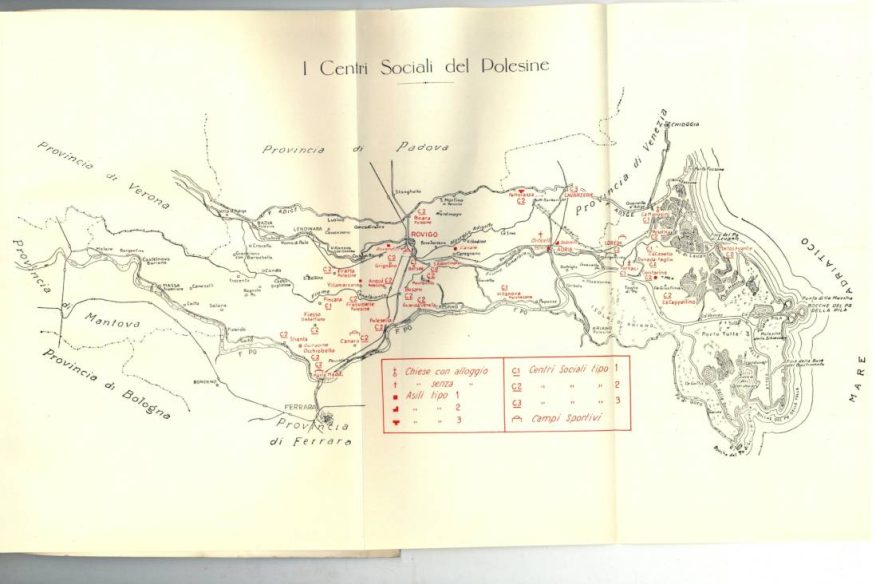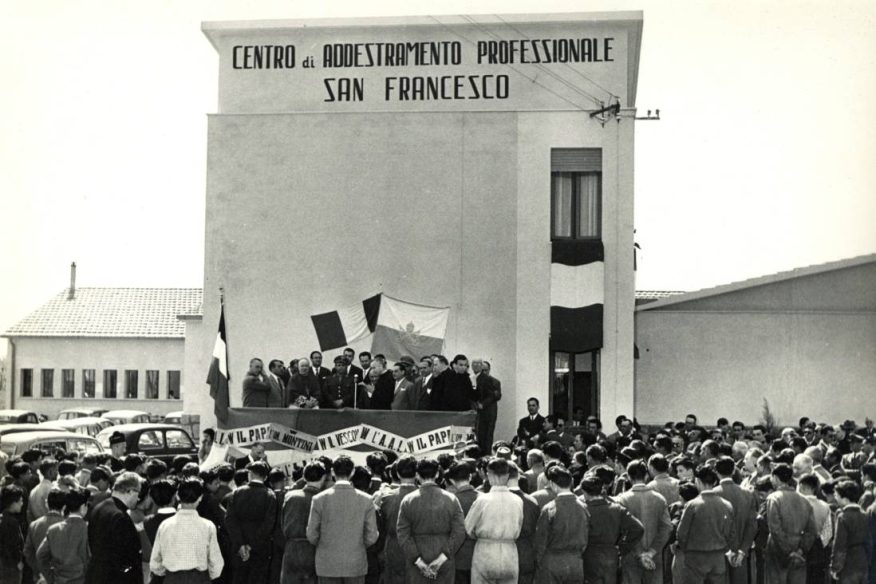The Polesine flood

A flood is capable of sweeping away everything: entire villages, human lives, memories and houses, disrupting the territory. How can an archive recount a flood?
If we think of Italian floods, the one that has remained most impressed in the collective imagination is that of Florence, which occurred on 4 November 1966. However, there have been many floods before and after the one remembered for the ‘Mud Angels’.
In November 1951, due to intense rainfall that fell for days, especially between 12th and 14th, the flooding of the river Po’ affected the area of upper, middle and lower Polesine. It swept over several towns.
The event is also remembered in cinematography. The 1953 film ‘The Return of Don Camillo’ ends precisely with the flooding of the town of Brescello where the story is set. Some of the shots of the swollen river and the flooded fields of the Bassa were made two years earlier, in 1951, precisely during the flooding of Polesine that also affected the places where the characters created by Guareschi lived.
Sources
In order to better understand this dramatic event and its consequences, we can make use of some sources preserved in our Historical Archives.
In fact, in the Veneto-Milan Province fonds there are some files kept in the folders of Adria and Albinea, two of the many towns and villages affected by the flood.
Our papers do not deal directly with the dramatic event itself but with its aftermath and what happened afterwards: the work of months and years to rebuild the towns, make the territories safe, and rebuild the social fabric.
In fact, following the Polesine tragedy, the Society of Jesus was among the bodies and institutions that moved to rebuild.
After the flood
Relief activities for the flooded population began immediately. The Italian government, which had also received many donations from other nations in favour of the flooded population, had initially entrusted the task of reconstruction to the Ente Nazionale per la Distribuzione dei Soccorsi in Italia (ENDSI).
Following an agreement, the first buildings constructed were handed over to the POA, the Vatican’s Pontifical Work for Relief. Coordinated by Monsignor Baldelli, the parish priests, the bishops of the hardest hit dioceses and the Jesuits began a large project that included not only the completion of the buildings, but also the setting up of a network of social centres, distributed throughout the Polesine area.
In the picture we see the capillarity that the Poa was able to reach through churches, with or without accommodation for the parish priest, kindergartens, social centres and sports grounds.

Our Archives contain the minutes of dozens of meetings convened by the Poa to coordinate the reconstruction work, as well as documents testifying to the initiatives undertaken in the aftermath of the tragedy, budgets, plans and reports. The buildings were finished as early as 1954, while many were enlarged. New centres and parishes were inaugurated every month, until the project came to an end at the end of the 1950s, when the Society of Jesus remained for a few years, continuing the apostolate.
Not only reconstruction
It was clear that it was not enough to rebuild infrastructure and housing, but it was also necessary to spiritually and apostolically animate the area, which had already received little assistance before the tragedy.
Right from the start, the meetings did not lose sight of practical needs: mattresses and pillows were ordered for the kindergartens, bedside tables, bedsteads and wardrobes. However, great attention was paid to the social aspect, with the construction of bars, the supplying of no less than eight football teams, licences for cinemas, and the purchase of a TV set (we are right at the dawn of television).
Bishop Baldelli also frequently visited the flooded areas to supervise the work, attend meetings, and take stock of the situation and report news from Rome.
The POA had several organisational structures: the inter-diocesan committee composed of the bishops of Adria and Chioggia and their delegates, the President of the Poa, Monsignor Baldelli, and Fr. Vito Lorenzi, a Jesuit, delegate of the POA.
There was also an executive council, which included a woman, Velia Marzullo, in charge of Social Assistance. An inter-diocesan council of parish priests from the two dioceses, Adria and Chioggia, supported these bodies.
Lastly, a series of inter-diocesan technical councils had been established, which tell a lot about the apostolic goals, not only the reconstruction of buildings but also of the actual social fabric. There was in fact the cinema council, the theatre council, the health care council, the education council and the sports council.
The new social fabric
The post-flood period was therefore an opportunity not only to rebuild homes but also to provide the territory with social structures and also guarantee health care that would greatly improve the lives of workers.
Thus, kindergartens, social centres were planned and built, also with the ambition of taking away as much audience as possible from the left-wing parties; in one of the publications dedicated to the social centres of Polesine, in fact, the territory is defined as ‘land beaten by socialism and now fought by the raging communism.
The objective was not only to bring families and workers back to the Catholic Church, but also to combat the illiteracy that characterised the agricultural territory of Polesine at the time.
In the newly rebuilt schools, after-school activities were organised so that children and young people had a place to stay after school hours. The Society of Jesus had already been running the S. Giuseppe recreation centre in Florence for four decades with similar aims and in the same years it also opened an after-school centre in nearby Conegliano.
There were also workshops, carpentry, welding, plumbing, mechanics and masonry, to accommodate those who need to learn a trade. The S. Francesco professional training centre in Adria arose for this purpose.
Different types of kindergartens were provided for the children, distinguished by size and equipped with canteens. Many of these facilities were enlarged after only a few years, such was the influx of children enrolled by families.
Childcare also took the form not only of opening kindergartens but also of organising holiday camps, which for many families represented the only possibility of allowing their children to spend some time at the seaside or in the mountains.
Particular attention was given to social facilities, as shown by the meetings focusing on the construction and setting up of theatres and cinemas. Topics on the agenda included curtains for theatres and stages, armchairs and projectors for the cinema.
The focus on the recreational aspect took shape not only in the construction of theatres, cinemas and the ‘philharmonic’, but also in the bars, which were considered a meeting and social point for the area.
In addition, sports fields were completed and equipped to practice various sports for children and adults.
There is the charisma of the Company, which has always identified theatre as a pedagogical tool, in the watermark. In the Company’s boarding schools, there was always a theatre where the children could stage many shows during the school year.
Even in Polesine, children tried their hand on the stage, as some photos in the folders testify.
Fr. Francesco Salto
One of the most active Jesuits was Fr Francesco Salto. For some years, he carried out his apostolate not far from those territories. His obituary, published in the journal ‘Notizie della Provincia Vento – Milanese’, recalls that the Jesuit used to reach the rice fields, in every possible climate, to hear the confessions of the workers and provide them with Mass and the Eucharist.
After the flood, he was among those who tried to help the people, with personal initiatives: he ensured the arrival of medicines, tried to give work to men and women, and took a special interest in workers and labourers and their living conditions.
The Jesuit also realised that it is not the mere distribution of food or objects that can lift the population’s living conditions. We read from a letter he sent to one of the social workers:
I have received the cheque […] I want to spend it on my ingenious or crazy initiative to buy fishing boats to lend to the poorest. [Providence made me find two excellent local masters who do really well and are very ingenious. At their suggestion, I bought a clamp and some files: soon we will begin an experiment with the children of the colony in a small workshop, where they will make something useful: birdcages, salt tins and matches. Pray that the initiative succeeds. At the end of the colony, we will have an exhibition of the work and an award ceremony. […] I bought the projection machine and Don Bosco films. We will make the projections for the children at the colony.
The account of his funeral, much attended by the population, is found in a document sent to the communities of the Veneto – Milanese Province to be read at the table for the benefit of all the Jesuits. Unfortunately, Fr. Salto died falling into the Adige River while carrying out his apostolate. He was accompanying children from one of the colonies. The children from the workshop made him an iron cross, which was placed on the coffin as a sign of recognition for what he had done for them.
In addition to Fr Salto, many Jesuits were active in Polesine, among them the aforementioned Vito Lorenzi and Fr Messori Roncaglia, who was appointed Triveneto delegate by the Poa precisely for Polesine.
The history of the Jesuit apostolate in Polesine has yet to be studied, these papers in fact only became available for consultation a few years ago, with the opening of the pontificate of Pius XII.














